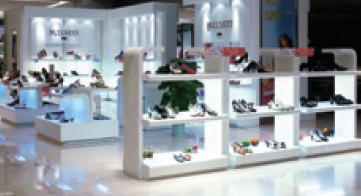introduction
The indoor key lighting design of department stores is an important means to create a humanized and personalized shopping environment. In order to attract the attention of shoppers, designers need to deal with the relationship between general lighting and accent lighting, highlighting the highlights. The proper use of light and dark contrast can greatly enhance the curiosity of shoppers and promote sales. In the department store, the lighting effects required for different locations are different, and the key lighting factors are also different. The relationship between the key lighting factors and lighting effects is shown in Table 1. Entrances to department stores, shop windows, high-end goods, checkout counters, landscape spaces, etc. are usually the key lighting areas.
1 entrance and foyer lighting
In addition to passing on the brand identity of the store, the department store entrance also requires the entrance of the store to stand out from the surrounding environment and attract shoppers to enter the store. Lighting at the entrance is generally higher than the average indoor illumination, with an emphasis of approximately 1.5 2 . The choice of color temperature should be coordinated with the interior and differentiated from the surrounding stores (Figure 1).

Figure 1 Entrance and hall photos of a department store
2 window lighting
The window is the window of the show store and the reflection of the store image. The goal of window lighting design is to faithfully reflect the color, texture, etc. of the product, and only good control of the beam direction can achieve good results. Select lighting adjustable angles or rails recessed downlights spotlight. The key light and supplemental light are usually placed in the two corners of the top of the window to illuminate the item, and light is placed from the back of the window to highlight the outline of the item and separate it from the background. This method of light processing is also suitable for the display of transparent objects, and the light from the bottom up is generally dramatic. Through the comprehensive utilization of illumination light of different angles such as these, the product can be effectively highlighted and the display effect can be improved. Since the window usually faces the outdoor street or indoor main pedestrian flow, the illumination is generally required. Window lighting usually consists of two sets of lighting systems: one for the evening and night, with ordinary tungsten halogen lamps; the other for daytime, providing sufficient background brightness. During the day, the shop window usually uses cold color (4 000K) high color rendering (a>80) general illumination, illumination is 500 1 500lx; the key illumination factor is about 6 10, so that it can not only protrude from the adjacent window, but also It can reduce the influence of window glass interference reflection, improve contrast and attract shoppers. In the department store, the brightness of the window part is generally 23 times higher than the surrounding environment (Figure 2) to increase the attention of shoppers. At night, the shop window usually uses contrasting, high color rendering (a>80), intermediate color temperature (3 000 3 500K) illumination, and the illumination of 500lx can form an appropriate scene to attract the evening shopping crowd.

Figure 2 Highlight lighting of a department store window
3 commodity lighting
The use of the key light environment can show the gloss of the surface of the product and the excellent texture to create an artistic effect. The display lighting of department stores usually uses circular, narrow beam or wide beam spotlights to make the illuminated display objects stand out from the background. Commodity lighting is typically achieved by a wide beam spotlight or an adjustable angle point source spotlight. Asymmetrical light distribution systems are also commonly used for shelf lighting (Figure 3).

Figure 3 Display lighting of the shelf
In the optical belt system, it is also becoming a trend to merge into a spotlight or a spotlight downlight. Since the spotlight installation is closer to the shelf, a certain degree of uniform illumination can be obtained. In addition, the point source creates shadows and sparkles on the merchandise, and the strips produce effective functional illumination. The key lighting generally uses the directional key lighting fixtures to create a certain shadow on the front of the exhibits and the mannequins, creating a unique shape. The intensity of the shadow of the exhibit depends on the ratio of its front brightness to its neighboring environment or background brightness. The larger the ratio, the stronger the shadow and the better the shape. The accent lighting is usually about 3.5 times the brightness of general lighting. The key lighting can only appear “outstanding†under the illumination of ordinary lighting. Therefore, general lighting is given to general merchandise, and the promotion of booths or key commodities focuses on “chargingâ€, combining general lighting with accent lighting to achieve overall effect. In most cases, only by keeping the general lighting "low-key", the key lighting products can get a strong visual impact (Figure 4), stimulating the desire of shoppers to buy. The setting of key lighting is more effective in giving priority to quality product display.